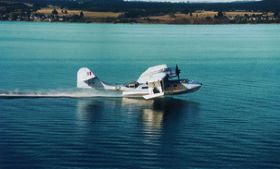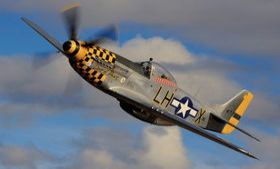Past Airshows > 2008 Airshow > 2008 Aircraft
Polikarpov I-16
|

|
Polikarpov I-153
|

|
Hawker HurricaneThe first RAF monoplane fighter, and its first capable of more than 300mph, the Hurricane proved throughout the war to be a highly adaptable and versatile fighter. After serving valiantly in the Battle of France in 1940 it equipped more than 60% of Fighter Command squadrons during the Battle of Britain. The type shot down nearly half the total of enemy aircraft destroyed in the first year of the war; in the Western Desert it was an effective light bomber and tank buster; at sea it was a valuable convoy protector; in the Far East it served as a night fighter; and in Russia it did sterling work with the Soviet Forces. Over 14,000 examples were built during WWII and now Hawker Hurricane P3351/DR393 is one of only ten airworthy examples in the world. It is a survivor of the Battle of France, Battle of Britain and Battle for Russia. |

|
Sopwith TriplaneThe Sopwith Triplane was designed in 1916, 150 being built. It made its appearance on the Western Front with the RNAS, completely outclassing the German Albatross. Fokker was able to obtain a wrecked "Tripehound" as they became known, and it was not long before Fokker began producing the famous Dr. 1 triplane. |

|
Consolidated PBY CatalinaThe RNZAF operated 56 Catalinas in the Pacific during WWII. Stabilizing floats which, when retracted in flight formed streamlined wing tips, were unique innovations which made this aircraft ideal for use in the surveillance, anti submarine, air/sea rescue and convoy patrol roles. ZK-PBY, flown by the Canadians in WWII, was purchased by the Catalina Group and arrived in New Zealand in 1994. |

|
Fokker D.IVThe Fokker D.IV was built for the Swedish Government in 1917, for the defence of Stockholm. The purchaser was required to provide its own engines and armament. The D.IV was not a successful design and only four were built for the Swedes and three others. They were locked up until 1922 by which time they had become totally obsolete. |

|
Klemm KL 35Hans Klemm was fifty years old when he designed the Klemm Kl 35. The German Luftwaffe could see no future in the aircraft, but Klemm persisted and in 1935 the first of his designs took to the air. Powered by a Hirth 4 cylinder air cooled engine delivering 105 hp, the Klem 35 could cruise at 212 km/h. This little aircraft was later recognized as successful and ordered in quantities by the Luftwaffe. You will see two examples at WOW 08. |

|
Curtiss P-40 KittyhawkFirst flown in 1938, the Curtiss Kittyhawk operated in almost every theatre of war in WWII. The RNZAF operated 297 of these fighters in the Pacific during WWII and were responsible for downing 99 Japanese aircraft destroyed. Replaced by the Corsair in 1944 the P-40 returned to New Zealand as an advanced fighter trainer. |

|
Pfalz D111The Pfalz D111 entered WW1 in 1917. Powered by a 160 hp Mercedes engine, the Pfalz D111 was found to be heavier than the Fokker and Albatros, both of which it was to replace, and often lost height during engagements with Allied aircraft. It was, however, structurally very sound and helped improve the German Air Forces fortunes at a time when the Allies had been enjoying relative air superiority. This rare replica Pfalz was one of the stars of the movie Blue Max. |

|
L-39 AlbatrosThe Czechoslovakian L-39 was built as the successor to their earlier trainer, the L-29 Delfin. Design work began in 1966, and the first prototype made its initial flight on 4 November 1968. The idea of the design was to marry an efficient, powerful turbofan engine to a sleek, streamlined fuselage, resulting in a strong, economical performer which would become the next standard jet trainer for the Warsaw Pact. Full-scale production was delayed until late 1972 due to apparent problems with the design of the air intakes, but these difficulties were overcome and the type went on to be a great success with the Soviet, Czech and East German air forces, among others. |

|
de Havilland DH82A Tiger MothThe most famous of all de Havilland aircraft in this country is the Tiger Moth. Flown in its hundreds in the Airforce, topdressing, aero club, gliding club and private use it was once the primary trainer for NZ fighter pilots. It is being seen in increasing numbers as more long term rebuilds take to the air. |

|
North American HarvardIn RNZAF service as a pilot trainer for more than three decades the Harvard was first flown in 1937. Know as the Harvard in the British Commonwealth, T-6 Texan in the USAF and SNJ by the US Navy, over 21,000 examples were built. The Harvard was used as the primary trainer for most Commonwealth aircrew during WWII, after they had flown solo in the Tiger Moth. Fully aerobatic, it was a delight to fly, but not too easy for the novice who one day would move onto single seat fighter aircraft. |

|
Douglas C-47 DakotaThe most versatile workhorse aviation has known. Born in the 1930s it became the standard pre-war airliner, went to war in uniform the world over, and returned to civilian clothes afterwards. This C47 is painted in the livery used by the RNZAF until the fleet was replaced by ex-RAF Andovers in the late 1970s. Note the NAC marking as a gesture to the National Airways Limited who used them extensively on New Zealand's domestic routes. |

|
de Havilland VampireThe Vampire was the UK's first single-jet fighter, the prototype flying in September 1943. Entering service with the RAF in 1946 the type also became the RNZAF's first operational jet aircraft. The first Vampires arrived in 1951-52 and went to form No.14 and No.75 Squadron at Ohakea. Remaining in service until 1972 when replaced by the Strikemaster the type was flown by 21 countries including Australia - where 109 were built under license. The Vampires at WOW 2006 are the Tll 2 seat trainer version. |

|
Yakovlev Yak-52Designed in Russia and manufactured in Romania, the YAK-52 emerged as a further development of the YAK 18-A. Not used as a military aircraft, the YAK-52 was used by paramilitary and sport flying groups throughout the Soviet Union. Stressed to plus 7-minus 5 Gs and powered by a 360 hp Vendeneyev M-14 P nine cylinder radial engine, the aircraft makes an ideal aerobatic trainer and performer. |

|
Yakovlev Yak 3-MNicknamed "Dogfighter Supreme", the Yak 3 was the ultimate refinement in Soviet wartime fighter development. The smallest and lightest combat fighter of WW11, upon entering combat with the Luftwaffe it was found to be so much superior to the Focke-Wulf 190 and the ME-109 that a signal was sent to all squadrons saying, "avoid all combat below 10,000 feet with any Yak fighter lacking an oil cooler under the nose". |

|
Lavochkin LA-9Built by Syemon Lavochkin (a pupil of Ilyushin) in 1945, the Lavochkin La-9 took its first flight on June 26 1946. Very similar to the La-7 and La-11, its 1850hp Shvetsov radial piston engine can reach over 400mph at top speed. Pilots rear-view was constricted by a deep aft end fuselage so the very similar, and more famous, long range escort La-11 was produced as an alternative. The North Korean Air F orce, at the outbreak of the Korean War in mid 1950, bought numerous La-9s. Over 1630 single-seater La-9s were produced, the majority of them finding service in the air war over Korea. |

|
Corsair FG1DThe Goodyear FG-1D Corsair is powered by a 2000hp Pratt and Whitney radial engine and can cruise at 44,000ft. It can travel at 450mph with a range of 1500km without refueling. Nicknamed "Whispering Death" by the Japanese because of its exceptionally quiet approach, the Corsair soon helped gain air superiority. Corsair NZ5648 is the last remaining of the 400 operated by the RNZAF during WWII. |

|
Supermarine Mk IX SpitfireThe Supermarine Spitfire was one of the most famous fighters in WW11. This Mk IX is powered by the famous Rolls Royce Merlin V twelve engine. It is fitted with two seats as a trainer as used by the Israeli and Irish Air Forces. This particular aircraft is painted to represent the Spitfire flown by American, Major Robert Levine of the 4th Fighter Squadron in the Middle East. |

|
Thunder MustangThere are just ten of these amazing planes flying in the world. The Thunder Mustang, built from high-tech modern materials and powered by a 640 horse power Ryan Falconer V12 racing engine, out performs the original P51-D Mustang . This aircraft is a most exciting addition to the New Zealand aviation scene and will be demonstrated at WOW 2010. |

|
North American P-51D MustangThe British inspired, American built Mustang was one of the most potent and versatile fighters of WWII. Operated as a long range escort and in the close air support role, It became the first fighter capable of accompanying American bombers all the way to Berlin and back. When first flown in 1940, it was powered with an Allison engine but later models were powered by a Packard Merlin, which provided it with considerable extra power at higher altitudes. It became known as the "Cadillac of the skies". |

|
Nieuport 11Designed by Gustave Delage in 1914 for racing, the Nieuport 11 was affectionately known as "Bebe". (Baby) The aircraft, being light, fast and maneuverable, was quickly pressed into service as a fighter to counter the German Fokker E.111 Eindeker in1916. The only disadvantage was the aircraft's gun had to be fired by use of a gunmount on the top wing as it had no interrupter gear to enable it to be fired through the propeller arc. The Nieuport 11 was used in both Italy and the Western Front until 1917. |

|
Gyrate EagleThe MT 03 Eagle is a tandem two seat gyroplane built in Germany. Powered by a Rotax 4 stroke 100 hp engine using a "pusher" propeller, the Eagle takes off in between 10 and 70 metres, has a cruise of 152 kph, a minimum speed of 32 kph, a landing run of 15 metres and a fuel endurance of 3 hours. A useful vehicle for pleasure, observation, aerial photography, mustering, scenic flights and even rural property management. Possibly the personal transport of the future. |

|
NA T-28 TrojanThe T-28 Trojan was North American's successor to the AT-6 Harvard. First flown in 1949, the T28 Trojan was accepted into US service powered by an 1194 hp R-1300 P&W engine for use by the USAF. In 1954, the T28 was re-engined with the more powerful 1425 hp R-1820 and fitted with an arrester hook and six more "hard points", for use by the US Navy. The Trojan saw service in Vietnam. Although the T28 has no military connection with New Zealand, this syndicate owned aircraft is a valuable part of military history. |

|